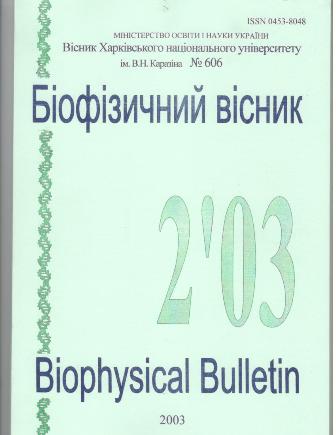Carbonyl vibration resonance interactions in collagen structures
Abstract
Resonance interaction of the carbonyl vibrations for model collagen structure [(PRO-PRO-GLY)10]3 have been treated on the basis of molecular exciton theory in a dipole-dipole approximation. The frequency shifts of the carbonyl vibrations induced by dipole coupling, inter-peptide and peptide-water hydrogen bond formation were obtained. The relative contributions of energies of peptide-water and inter-peptide hydrogen bonds and energies of other types of interaction to the total stabilization energy were estimated for the model collagen structures.
Downloads
References
Eliot A. Infrakrasnye spektry i struktura polimerov. M.:Mir; 1972. (in Russian)
Lazarev YuA, Chishkovsky BA, Chromova TB. Amid I band of IR spectrum and structure of collagen and related polypeptides. Biopolymers. 1985;24(7):1449-78.
Yonath A, Traub W. Polymers of as collagen models IV. Structure analysis of poly (L-proly-glycy-L-prolyne). J. Molecular Biol. 1969;43(3):461-77.
Okuyuma K, Arnott S. Crystal and molecular structure of a collagen-like polypeptide (pro-pro-gly)10. J. Mol. Biol. 1981;152(2):427-43.
Lazarev IuA. Strukturoobrazovanie spirali kollagenovogo tipa v sinteticheskikh oligo- i politripeptidakh. Dis. dok. fiz.-mat. Nauk, Moskva, MGU, 1987.
Miyazawa TJ. Pertubation treatment of the characteristic vibrations of polypeptide chains in various configuraytions. J. Chem. Phys. 1960;32:1647-52.
Krimm S, Abe Y. Intermolecular interaction effects in the Amide I vibrations of B polypeptides. Proc. Nat. Acad. Sci. USA. 1972;69(10):2788-92.
Chirgadze IuN, Nevskaia NA. Rezonansnye vzaimodeistviia osnovnykh amidnykh kolebanii v uporiadochennykh peptidnykh strukturakh. Dokl. AN SSSR. 1973;208(2):447-50.
Fukushima K, Jdeguchi Y, Miyazawa T. The normal vibrations of polyglycine I. Bull. Chem. Soc. Japan. 1963;36:1301-7.
Semenov MA, Bolbuch TV. Carbonyl vibration resonance interactions helical polynucleotides Poly(dA)-Poly(dT) and PolyG-PolyC. Studia biophysica. 1984;102(3):215-20.
Semenov MA, Bereznyak EG. Hydration and stability of nucleic acids in the condenced state. Comments Mol. Cel. Biophys. 2000;10(1):1-23.
Davydov AS. Teoriia pogloshcheniia sveta v molekuliarnykh kristallakh. Kiev: AN USSR; 1951.
Semenov MA, Bolbukh TV. Rezonansnye vzaimodeistviia karbonilnykh kolebanii v spiralnykh polipeptidakh. Kharkov; 1982. p.28.
Berisio R, Vitagliano L, Mazzarella L, Zagari A. rystal structure of the collagen triple helix model [(PRO-PRO-GLY)10)3. Protein Sci.2002;11:262-70.
Gribov LA. Teoriia infrakrasnykh spektrov polimerov. M.:Nauka; 1977. (in Russian)
Basharov MA, Volkenshtein MV, Golovanov IB, Lazarev IuN, Sobolev VM. Nπ-sviazi v amidakh i peptidakh. Dokl. AN SSSR. 1986;287:211-5. (in Russian)
Semenov MA. Gidratatciia i strukturnoe sostoianie nukleinovykh kislot v kondensirovannom sostoianii. Dis. dok. fiz.-mat. nauk. Moskva:MGU. 1990. (in Russian)
Gasan AL, Maleev VYa, Semenov MA. Role of water in stabilizing the helical biomacromolecules DNA and collagen. Studia. Biophysica. 1990;136(2-3):171-8.
Engle J, Chen H-T, Prockop DJ. The triple helix-coil conversion of collagen-like polytripeptides in aqueous and nonagueous solvents. Comparison of the thermodynamic parameters and the binding of water to (L-Pro-L-Pro-Gly)n and (L-Pro-L-Hyp-Gly)n. Biopolymers. 1977;16:601-22.
Authors who publish with this journal agree to the following terms:
- Authors retain copyright and grant the journal right of first publication with the work simultaneously licensed under a Creative Commons Attribution License that allows others to share the work with an acknowledgement of the work's authorship and initial publication in this journal.
- Authors are able to enter into separate, additional contractual arrangements for the non-exclusive distribution of the journal's published version of the work (e.g., post it to an institutional repository or publish it in a book), with an acknowledgement of its initial publication in this journal.
- Authors are permitted and encouraged to post their work online (e.g., in institutional repositories or on their website) prior to and during the submission process, as it can lead to productive exchanges, as well as earlier and greater citation of published work (See The Effect of Open Access).





